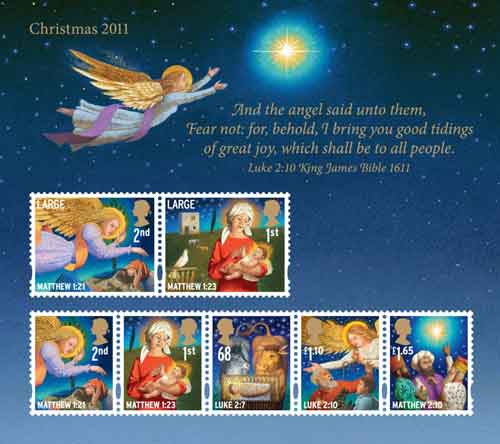 On Tuesday 8 November UK’s Royal Mail issued their Christmas Stamps for 2011. It is a delight to see Christmas stamps that are actually Christmas stamps. This year’s stamps celebrate the 400th anniversary of the King James Bible.
On Tuesday 8 November UK’s Royal Mail issued their Christmas Stamps for 2011. It is a delight to see Christmas stamps that are actually Christmas stamps. This year’s stamps celebrate the 400th anniversary of the King James Bible.
There’s just one problem: the second-class stamp has a picture of an angel with a dreaming Joseph. This is referenced on the stamp to Matthew 1:21. That, of course, is incorrect. The correct verse (in the 1611 King James version) is, of course, Matthew 1:20:
20. But while hee thought on these things, behold, the Angel of the Lord appeared vnto him in a dreame, saying, Ioseph thou sonne of Dauid, feare not to take vnto thee Mary thy wife: for that which is conceiued in her, is of the holy Ghost.
[ps. for those interested in details, the quote given on the sheet from Luke 2:10 is from the 1769 revision of the King James Version, not from 1611]
Update 15 November: I appreciate it very much that Philip Parker, Head of Stamp Strategy, Royal Mail, replied that
The intention with our Christmas stamps this year was deliberately to reference Matthew 1:21.
This is what the angel actually says to Joseph where ‘Jesus’ is named and gives the importance of him coming into the world. “And she shall bring forth a son, and thou shalt call his name JESUS: for he shall save his people from their sins.”
That is why we also run the text – ‘Thou shalt call his name Jesus’ – up the side of the stamp books of 2nd class stamps.





It’s BOTH 20 and 21 isn’t it? And it’s the 21, not 20, that talks about Jesus. My guess is that if they were to put “20-21”, that would be longer text and obscure too much of, or overbalance, the picture.
I wouldn’t call that “biblical ignorance”.
What worries me far, far more than such gnat-straining is all the camel-swallowing that we music-choosers inflict on our congregations at Christmas, when choosing the heretical docetism of “Away in a Manger”. (And close behind it in the heresy stakes come “Silent Night” and “Once in Royal”.) If we were REALLY worried about biblical ignorance, wouldn’t we be better looking a little closer to home?
Thanks for your comment, David. I am quite comfortable for you to disagree with me. Suggesting that someone is “gnat-straining” is not the way we discuss things here, however.
I would be quite happy with Matthew 1:20f. or Matthew 1:20-21. I think neither would obscure the picture – as there are already two different image formats for this same quote – one more obscuring than the other. I stand by Matthew 1:21 being incorrect, and think the intention of the stamp producers was Matthew 1:20.
The three Christmas carols you quote I am convinced can be sung by persons holding completely Orthodox beliefs.
Blessings
Ah well, Bosco. Things are looking up in ACANZP. The new Dean of Studies at St.John’s College (Pakeha College) is Dr. Helen-Ann Hartley, whose PhD – connected with her recent book about the Bible – will help future students in their hermeneutical research into a modern understanding of the Scriptures. So at least we’re on the way to a new era of Biblical Literacy. (Trust you to suss out the exact detail of the quote about the Angelic visitation to Joseph, foster-father of Jesus).
Agape, Ron
Thanks, Fr Ron. Our province (on purpose?), as you know, does not keep any provincial statistics. Estimates are that about 7% of ordinands go to St John’s. Does being Dean there mean that these 7% will be lectured by her – if they are doing studies there I presume they are studying at Auckland University, not at St John’s. I appreciate your optimism but don’t share it. It sounds a good appointment, and she, the College, and our church have my prayers. Blessings.
I am more than happy with 21, because it is the specific verse that mentions the birth of Jesus, and the purpose of the incarnation. The angel is still talking to the dreaming Joseph, so there is no inaccuracy – rather the art gives context to the words. Let’s celebrate that the story is being told on these stamps. That’s the main thing.
Agreed, Mary. Blessings.
The intention with our Christmas stamps this year was deliberately to reference Matthew 1:21.
This is what the angel actually says to Joseph where ‘Jesus’ is named and gives the importance of him coming into the world. “And she shall bring forth a son, and thou shalt call his name JESUS: for he shall save his people from their sins.”
That is why we also run the text – ‘Thou shalt call his name Jesus’ – up the side of the stamp books of 2nd class stamps.
Many thanks,
Philip Parker, Head of Stamp Strategy, Royal Mail
Thank you very much, Philip, for taking the time to let us know the thinking behind this stamp. I reinforce my point above – it is a delight to see Christmas stamps that are actually Christmas stamps. I have updated the post to include your explanation. Blessings.